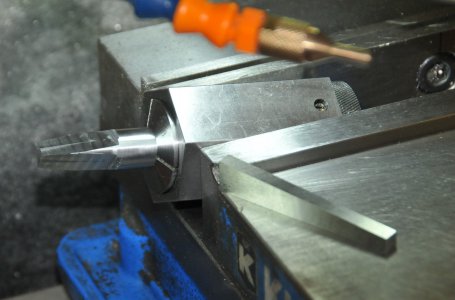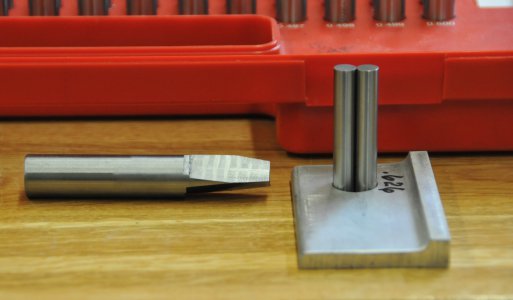Using Click Spring's video as a guide I made a 3 corner reamer. 5/8" O-1 rod. 5C hex collet block, 5° angle block. Mill the 3 tapers. Hone on a diamond "stone." Test on a junk 1/4" aluminum piece. I drilled 1/32 under then reamed on the mill. The O-1 measure .625 the resulting hole measured .626 with gage pins (.312 + .314) next .001" up wouldn't go in. The finish was pretty decent. I chose 5° thinking the longer taper would ease the cutting. My other choice was 10° which seemed kind of blunt. I should have had more of the rod sticking out of the collet so I could have run the taper all the way out. Need to do that so it fits in thicker material. Now I need to heat treat.
-
Welcome back Guest! Did you know you can mentor other members here at H-M? If not, please check out our Relaunch of Hobby Machinist Mentoring Program!
You are using an out of date browser. It may not display this or other websites correctly.
You should upgrade or use an alternative browser.
You should upgrade or use an alternative browser.
- Joined
- Apr 23, 2018
- Messages
- 6,556
I'm trying to see it, but it looks like a zero rake, zero clearance cutting edge. I do like the finish diameter being equal to the rod diameter, that's a real plus to keeping it easy and gives drill blanks another useful purpose. I don't think it would do well in bores, but on thin holes like your test piece I bet the tool worked great. You would not be able to do the same thing with a D-bit, the clearance and relief that make them work well would not make a good reamer. I think this is a variation on the primitive tri-facet drill, but only uses the upper portion of the grind to cut, as the tri-facet does to the wall of the hole. Seems quick, easy, and precise; probably suitable for all sorts of projects within its apparent limits. I'd like to see what the chips and finish look like.
True. I think it uses a scraping action rather than cutting. The hole needs to be close to finish size to start. In both aluminum & brass 1/32" under worked fine. The finish depends on how well the surface was honed. Both the brass and aluminum ended up with a nice glossy surface. I had used a "very fine" diamond hone. Even though I haven't spent the effort to get the tapered surfaces evenly polished the resulting hole finish was good. Only the high spots, those that the hone hit, were doing the finish scrape. They were traveling down the hole so covering the entire surface.but it looks like a zero rake, zero clearance cutting edge
I need to harden & temper to see what it will do in mild steel. Even if it wears relatively fast, it isn't a big deal. Not made for production work and easily re-honed. And the real winning thing for a cheap skate -- cheap to make.
The "chips" are more like fine scrapings. No danger of rats nests! I used the mill at relatively slow speed and hand feed.I'd like to see what the chips and finish look like.
I think one of the big advantages of these things is being able to easily make them come out to an exact size. Press fit tolerances!
Unlike the long shanks on reamers that allow them to sort of follow the hole, these just plunge straight in. Not sure what would happen if you made them long with a thinner shank.
- Joined
- Apr 23, 2018
- Messages
- 6,556
I might have to try this today. I have some ideas to tweak the basic design. I think grinding 3 simple gash flutes on the leading edge to advance the cutting angle and provide edges slightly beyond where the taper meets full diameter would help. Doing that will allow a relief grind to be made behind the cutting edge. Essentially, it would still have 3 edges, but should improve the bore depth capacity. Imagine a fusion between a multiflute countersink and this grind for a visual.True. I think it uses a scraping action rather than cutting. The hole needs to be close to finish size to start. In both aluminum & brass 1/32" under worked fine. The finish depends on how well the surface was honed. Both the brass and aluminum ended up with a nice glossy surface. I had used a "very fine" diamond hone. Even though I haven't spent the effort to get the tapered surfaces evenly polished the resulting hole finish was good. Only the high spots, those that the hone hit, were doing the finish scrape. They were traveling down the hole so covering the entire surface.
I need to harden & temper to see what it will do in mild steel. Even if it wears relatively fast, it isn't a big deal. Not made for production work and easily re-honed. And the real winning thing for a cheap skate -- cheap to make.
The "chips" are more like fine scrapings. No danger of rats nests! I used the mill at relatively slow speed and hand feed.
I think one of the big advantages of these things is being able to easily make them come out to an exact size. Press fit tolerances!
Unlike the long shanks on reamers that allow them to sort of follow the hole, these just plunge straight in. Not sure what would happen if you made them long with a thinner shank.



